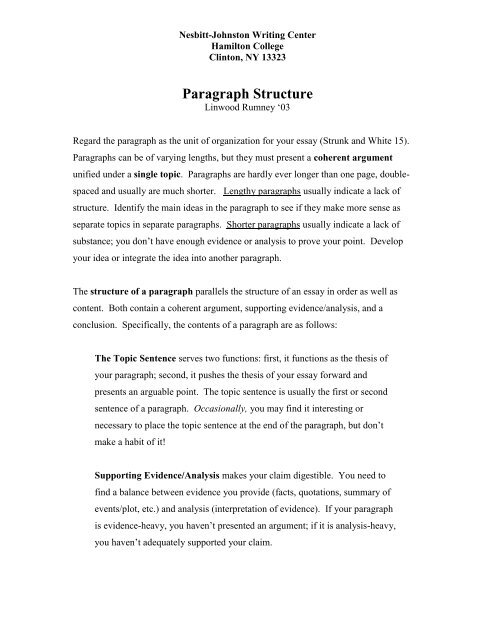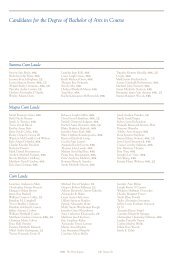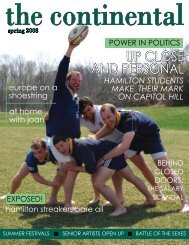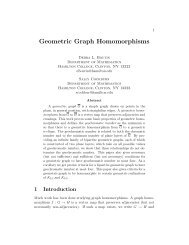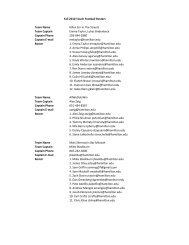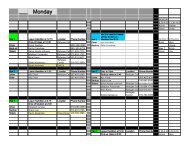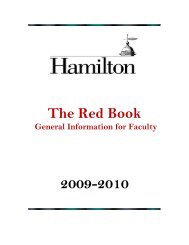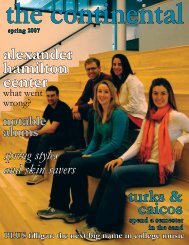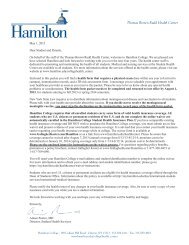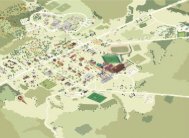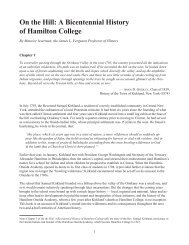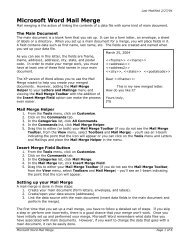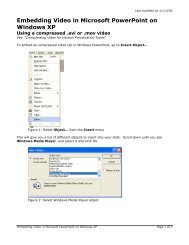Paragraph Structure - Hamilton College
Paragraph Structure - Hamilton College
Paragraph Structure - Hamilton College
Create successful ePaper yourself
Turn your PDF publications into a flip-book with our unique Google optimized e-Paper software.
Nesbitt-Johnston Writing Center<strong>Hamilton</strong> <strong>College</strong>Clinton, NY 13323<strong>Paragraph</strong> <strong>Structure</strong>Linwood Rumney ‘03Regard the paragraph as the unit of organization for your essay (Strunk and White 15).<strong>Paragraph</strong>s can be of varying lengths, but they must present a coherent argumentunified under a single topic. <strong>Paragraph</strong>s are hardly ever longer than one page, doublespacedand usually are much shorter. Lengthy paragraphs usually indicate a lack ofstructure. Identify the main ideas in the paragraph to see if they make more sense asseparate topics in separate paragraphs. Shorter paragraphs usually indicate a lack ofsubstance; you don’t have enough evidence or analysis to prove your point. Developyour idea or integrate the idea into another paragraph.The structure of a paragraph parallels the structure of an essay in order as well ascontent. Both contain a coherent argument, supporting evidence/analysis, and aconclusion. Specifically, the contents of a paragraph are as follows:The Topic Sentence serves two functions: first, it functions as the thesis ofyour paragraph; second, it pushes the thesis of your essay forward andpresents an arguable point. The topic sentence is usually the first or secondsentence of a paragraph. Occasionally, you may find it interesting ornecessary to place the topic sentence at the end of the paragraph, but don’tmake a habit of it!Supporting Evidence/Analysis makes your claim digestible. You need tofind a balance between evidence you provide (facts, quotations, summary ofevents/plot, etc.) and analysis (interpretation of evidence). If your paragraphis evidence-heavy, you haven’t presented an argument; if it is analysis-heavy,you haven’t adequately supported your claim.
The Concluding Observation closes your paragraph with an observation thatis more than just summary of the contents of the paragraph. The concludingobservation provides a final idea that leads to the next step in your argument.The observation is usually the last or second-to-last sentence in the paragraph.The following paragraph has been broken down into its constituent parts:Topic SentenceSupportingAnalysis andEvidenceEvidenceConcludingObservationThe means by which environmentalists seek to achieve their politicalgoals demonstrate a willingness to operate within traditional political channels.[point arguable: some people may believe environmentalists largely use antidemocraticstrategies.]Like many other special interest groups, advocates for the environmentalistmovement use lobbying tactics such as contributing financially to thecampaigns of environmentally friendly candidates. Lobbying provides asource of political influence and power. As one analyst of environmentalpolitics notes, in “making some commitment to work within the politicalsystem. . .[environmental lobby groups] succumb to. . .pressure to play ‘by therules of the game’ in the compromise world of Washington, D.C.” (Vig andKraft 70). [blend of supporting evidence/analysis]Some might argue that environmentalists have taken a distinctly anti-American approach to policy change, claiming that lobbying is inherentlyundemocratic in its bias towards certain segments of the population; however,lobbying remains a constitutionally legitimate form of political activism.[more than just summary, the point is arguable and could easily lead toanother point.]AcknowledgmentThank you to Jennifer Rose ’04 for permission to use the above paragraph.Works CitedStrunk, William, and E.B. White. The Elements of Style, fourth edition. Boston: Allynand Bacon, 2000.


